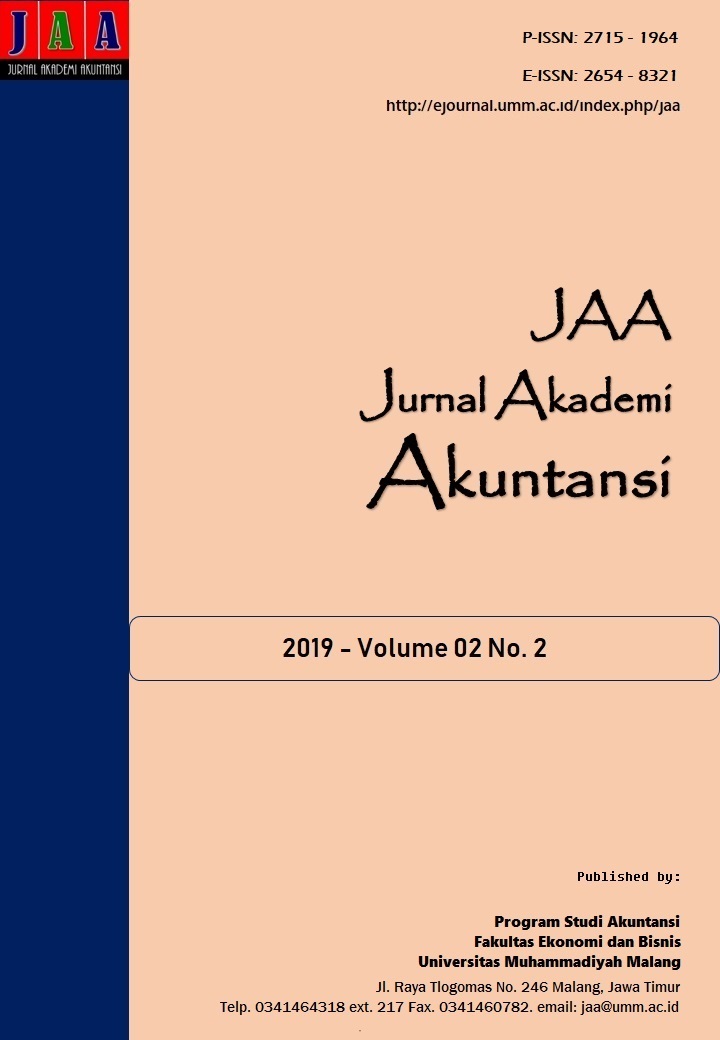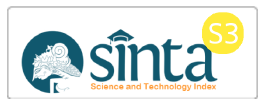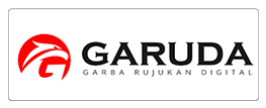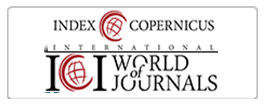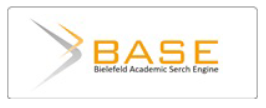INTELLECTUAL CAPITAL DISCLOSURE (ICD): A COMPARISON BETWEEN INDONESIAN AND CHINESE UNIVERSITIES
DOI:
https://doi.org/10.22219/jaa.v2i2.9998Keywords:
Index, Intellectual Capital Disclosure, University, 4ICUAbstract
The purpose of this study was to identify the practice of disclosure of information on intellectual capital on the website of the university in Indonesia and China. This research uses website the 10 best universities in Indonesia and China (version 4ICU survey 2018) as an object of study. Intellectual capital components used in this study is a framework developed by Leitner (2004) which consists of 36 items: 10 items of human capital, structural capital of 11 items, and 15 items of relational capital. The analysis used is content analysis, the different test performed using the Mann-Whitney test in SPSS. The results showed that there was no difference between the best universities in Indonesia and China to disclose information on intellectual capital through their website. In general, the number of IC disclosures through the best universities in Indonesia and China was around 45%, the rest is not disclosed.Downloads
References
Bjurstrom, E., and H. Roberts. 2007. The Principle of Connectivity: Networked Assets, Strategic Capabilities and Bundled Outcomes. In Intellectual Capital Revisited, edited by P. i. t. K. Organization. Cheltenha: Edgar Elgar. Bollen, L., P. Vergauwen, and S. Schnieders. 2005. Linking intellectual capital and intellectual property to company performance. Management Decision 43 (9):1161-1185. Bonavia, D. 1999. Cina dan Masyarakatnya. Jakarta: Erlangga. Bontis, N. 1998. Intellectual capital: an exploratory study that develops measures and models. Management Decision 32 (6):63–76. Bontis, N., W. C. C. Keow, and S. Richardson. 2000. Intellectual capital and business performance in Malaysian industries. Journal of Intellectual Capital 1 (1):85-100. Cahyuni, I., I. Ulum, and A. Prasetyo. 2012. Analisis Pengungkapan Intellectual Capital pada Official Website Peraih Qs Star di Indonesia 2011; Komparasi Antara Perguruan Tinggi Negeri (PTN) dan Swasta (PTS). In Simposium Nasional Akuntansi & Bisnis. Bandung. Canibano, L., and M. P. Sanchez. 2009. Intangibles in universities: current challenges for measuring and reporting. Journal of Human Resource Costing & Accounting 13 (2):93-104. Chang, S.-C., S.-S. Chen, and J.-H. Lai. 2008. The effect of alliance experience and intellectual capital on the value creation of international strategic alliances. International Journal of Management Science 36 (2):298-316. Chen, I., and J. Chen. 2018. Present and future: A trend forecasting and ranking of university types for innovative development from an intellectual capital perspective. Quality and Quantity 47 (1):335-352. Childs, R. D. 2018. An information age university: a living organism based on Intellectual capital 2011 [cited 01 Juni 2018]. Available from http://www.ndu.edu/irmc/publications/childs3.htm Commission Europe. 2006. The Commission Of The European Communities. Constantin. 2005. The intellectual capital of universities. Academy of Economic Studies: Bucharest. Constantin, B. 2007. The Intellectual Capital of Universities. Academy of Economic Studies. Deegan, C. 2014. Financial Accounting Theory. Sydney: McGraw-Hill Book Company. Ghozali, I. 2006. Statistik non-parametrik: Teori dan aplikasi dengan program SPSS. Semarang: Universitas Diponegoro. Indonesian Government Regulation Number 24 of 1997. Pendaftaran Tanah. Indonesian Government Regulation Number 43 of 2008. Air tanah. Jones, N., C. Meadow, and M.-A. Sicilia. 2009. Measuring Intellectual Capital in Higher Education. Journal of Information & Knowledge Management 8 (2):113-136. Law of the Republic of Indonesia Number 14 the Year 2018. Public Information. Leitner, K.-H. 2002. Intellectual Capital Reporting for Universities: Conceptual background and application within the reorganisation of Austrian universities. In The Transparent Enterprise. The Value of Intangibles. Madrid, Spain: Autonomous University of Madrid. ———. 2004. Intellectual capital reporting for universities conceptual background and application for Austrian universities. Research Evaluation 13 (2):129-140. Lu, W.-M. 2012. Intellectual capital and university performance in Taiwan. Economic Modelling 29:1081–1089. Martinez-Torres, R. 2006. A procedure to design a structural and measurement model of Intellectual Capital: An exploratory study. Information & Management 43 (5):617-626. Marzo, G. 2014. Improving internal consistency in IC research and practice: IC and the theory of the firm. Journal of Intellectual Capital 15 (1):38-64. Najim, N. A., M. A. Al-Naimi, and L. Alnaji. 2012. Impact of Intellectual Capital on Realizing University Goals in a Sample of Jordanian Universities. European Journal of Business and Management 4 (14). Orleans, L. A. 1960. Professional Manpower and Education in Communist China, Washington, National Science Foundation.111. Pribac, L.-I. 2010. Intellectual Investment. The Prospects In Education In The USA And In The Eu. Annals of the University of Petroşani, Economics 10 (1):279-288. Puspitahati, A., I. Ulum, and A. Prasetyo. 2011. Analisis Pengungkapan Intellectual Capital pada Website Tiga Perguruan Tinggi di Indonesia. Paper read at Proceeding Seminar Nasional & Call for Paper, 19 Februari 2011, at FE Universitas Muhammadiyah Sidoarjo. Ramírez, Y., C. Lorduy, and J. A. Rojas. 2007. Intellectual capital management in Spanish universities. Journal of Intellectual Capital 8 (4):732-748. Robert. 1999. The Control of Intangibles in the Knowledge-Intensive Firm. In Communication presented at 22th Annual Congress European Accounting Association. Burdox. Sanchez, M. P., S. Elena, and R. Castrillo. 2006. Intellectual capital in universities. Journal of Intellectual Capital 7 (4):529-548. ———. 2009. Intellectual capital dynamics in universities: a reporting model. Journal of Intellectual Capital 10 (2):307-324. Steward, T. A. 1997. Intellectual Capital: The New Wealth of Organizations. Fortune. Suciu, M.-C., I.-V. Dragulanescu, and A. Ghitiu-Bratescu. 2011. Universities’ Role In Knowledge-Based Economy And Society Implications For Romanian Economics Higher Education. Amfiteatru Economic 8 (30):420-436. Sugianto, E. I., and A. Trilaksana. 2015. Universitas Terbuka di Indonesia Tahun 1984-1994. e-Journal Pendidikan Sejarah 3 (2). Supomo, B., and N. Indriantoro. 2002. Metodologi Penelitian Bisnis. Yogyakarta: BPFE UGM. Tan, H. P., D. Plowman, and P. Hancock. 2007. Intellectual capital and financial returns of companies. Journal of Intellectual Capital 8 (1):76-95. Tung, M. T. 2001. Empat Karya Filsafat. Yogyakarta: FuSPAD. Ulum, I., and A. Juanda. 2016. Metodologi Penelitian Akuntansi. Yogyakarta: Aditya Media Publishing. Ulum, I., A. Tenrisumpala, and E. D. Wahyuni. 2016. Intellectual Capital Disclosure: Studi Komparasi Antara Universitas Di Indonesia Dan Malaysia. Jurnal Ilmu Akuntansi 9 (1):13 - 26
Downloads
Published
Issue
Section
License
Copyright (c) 2019 Aviani Widyastuti, Siska Aprillia

This work is licensed under a Creative Commons Attribution-NonCommercial-ShareAlike 4.0 International License.
Jurnal Akademi Akuntansi is licensed under a Creative Commons Attribution-NonCommercial-ShareAlike 4.0 International License.
Authors who publish with this journal agree to the following terms:
- Authors retain copyright and grant the journal right of first publication with the work simultaneously licensed under a Creative Commons Attribution-NonCommercial-ShareAlike 4.0 International License that allows others to share the work with an acknowledgment of the work's authorship and initial publication in this journal.
- Authors are able to enter into separate, additional contractual arrangements for the non-exclusive distribution of the journal's published version of the work (e.g., post it to an institutional repository or publish it in a book), with an acknowledgment of its initial publication in this journal.
- Authors are permitted and encouraged to post their work online (e.g., in institutional repositories or on their website) prior to and during the submission process, as it can lead to productive exchanges, as well as earlier and greater citation of published work (See The Effect of Open Access).
Jurnal Akademi Akuntansi dilisensikan di bawah lisensi Creative Commons Attribution-NonCommercial-ShareAlike 4.0 International.
Penulis yang menerbitkan artikel di jurnal ini menyetujui ketentuan berikut:
- Penulis mempertahankan hak cipta dan memberikan hak jurnal atas publikasi pertama dengan karya yang secara serentak dilisensikan di bawah Lisensi Pengaitan Creative Commons yang memungkinkan orang lain untuk berbagi karya dengan pengakuan atas karya penulis dan publikasi awal dalam jurnal ini.
- Penulis dapat masuk ke dalam pengaturan kontrak tambahan yang terpisah untuk distribusi non-eksklusif versi karya jurnal yang diterbitkan (misalnya, mempostingnya ke repositori institusional atau mempublikasikannya dalam sebuah buku), dengan pengakuan publikasi awalnya di jurnal ini.
- Penulis diizinkan dan didorong untuk memposting pekerjaan mereka secara online (misalnya, di repositori institusional atau di situs web mereka) sebelum dan selama proses pengajuan, karena dapat mengarah pada pertukaran produktif, serta kutipan pekerjaan sebelumnya dan yang lebih besar (Lihat Pengaruh Akses Terbuka).

